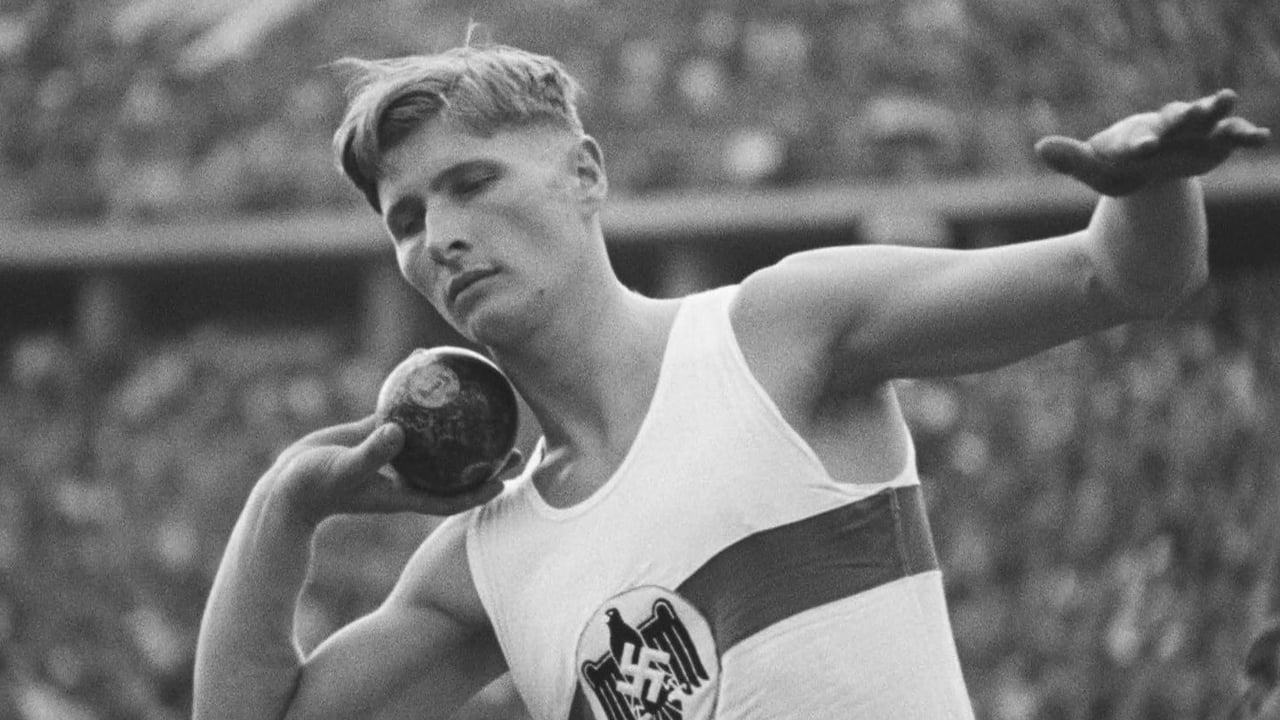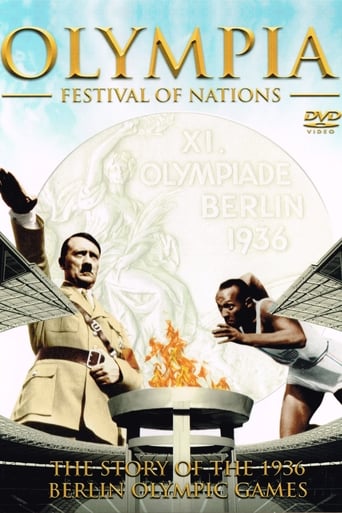chaos-rampant
The bulk of the film is dry, sometimes dramatic sports coverage. It must have been spectacular at the time, remember this was the first time that millions of people all over the world had the chance to witness the Olympics on a screen, and the first time the Olympics were the kind of lavish spectacle we have now, but yes, this aspect of it is mostly dull. You have to appreciate why this is so; Riefenstahl practically invented sports coverage with this film, the angles, the slow motion (a favorite 'replay' shot), the panoramic aerial views, all of it is common vernacular these days. All of it frees the viewer from a fixed place in the audience and allows him to float, to survey. All of it comes from the cinema.No, if this is worth it, it's because of this woman. The debate continues unabated, morally complicit or not, but obscures a simpler truth: she was a fascist in the most pure, most artistic way possible, fascinated by strength, youth, harmony, disciplined body. I thrive in the exact opposite sensibility, but have to admire her conviction in bringing it all alive.She was a dancer before making her transition to film, and this is her dance film. All of her films are about choreographed sculpted form in motion and Part II of this is the most pure, but this is worth watching. You just need to see the opening and marathon sequence.Glistening bodies dance, contort, spin, writhe, glide. The camera dances. Her vision swirls, teases, dissolves in dreamlike flow. She's over the top trying to evoke this business of a beautiful spirit, but in the way dancers usually are, trying to act out feelings. It's beauty that borders on caricature. Near the end, we see marathon runners give up from exhaustion, but a young boy goes on steadfast. He runs shirtless, ergo the shot is staged and was not part of the marathon, staged to give a glimpse of the bare Ideal; the sculpted young body shining with perspiration. But it's a Latin boy of dark skin, which is perhaps Riefenstahl's fascism on the most simple level; nothing racial, just this near-comically spiritual libido for vigor.And something else. Following Riefenstahl's cinematic dance from one film to the next is a valuable exercise in itself.In Daus Blaue Licht, it was a dance between her as brave mountain climber that fate beckons to and a mystery that existed to unveil itself as refracted light from the heavens. The valley people were fearful and duplicitous. In Triumph, it was between herself and the people she sculpted to be the mountain, the mountain flattened before a master, the soul sculpted to be resolute, immovable.Here the body is free again, free within confines of the sport, the mood is solemn but spontaneous, the same with the people. Once more we descend from the skies to watch a show that celebrates virtue and power. But this is much more subtle than Triumph, this impression of spontaneity. The crowds cheer freely. Blacks win. Jesse Owens is shown several times and in closeup. The Germans win again and again, but only because they did. Others win. A Japanese man triumphs in the marathon. The American flag waves frequently. The Nazi flag much less so. The Fuhrer nods and claps, pleased with all. It's all about sports and people celebrating. It never feels like you're watching a state-sponsored film.Don't you see? Everything is fine in Nazi Germany, everything normal and civilized. The summer of the previous year had seen the Nuremberg Laws on German purity of blood. Nazi signs against Jews in '36 had been carefully removed in anticipation of visitors.The Nazis, masters of the sensual and overblown, invented the Olympic torch-relay for the Games. They made sure these were the first Games to receive televised coverage. They directly financed the film about them, a prestigious production. It was all staged for everyone to see the image they wanted to broadcast.The following year, Charlie Chan at the Olympics showed the shrewd detective helping out Berlin authorities against a ring of enemy spies. Nazi paraphernalia were carefully expunged from the picture. See, nothing was wrong in the country except enemy spies trying to steal a gizmo.
wfgwilliams
The opening of this film surprised me. It takes about twenty minutes to get from the credits to the scene of the Olympic Games. There are scenes of Greek ruins dissolving into scenes of more Greek ruins. These flow to a long shot of the Acropolis.This is followed with Greek statues, that eventually make the transition into living men and women. Though they are naked, Riefenstahl presents them in the same aesthetic sense as the statues. First there are men doing some of the traditional track and field events: discus throwing, shot put, and so on. Then there are women dancing.The dancing women transform into flames, which lights a torch. A runner carries the torch away from the Greek ruins and from there the film follows the relay of torches to the stadium in Berlin.The opening sequence alone makes this film worth your time.There are some opening ceremonies where the athletes march onto the field. Adolph Hitler opens the games. The torch is lit.From that point on the film becomes a documentary of the major track and field events of the 1936 Olympic games.However this is not a by-the-numbers presentation of the games. Leni Riefenstahl presents the events through the lens of her aesthetic vision. She even pushes the suspense of the outcome of the sporting event with reaction shots, and other cinematic devices.There is propaganda in this film, but I believe Riefenstahl downplayed that aspect of the games.Everything I've read on this film mentions Jesse Owens. Hitler and by extension the Third Reich looked upon black people as inferior. However from the way Jesse Owens and other black athletes are photographed and presented in this film it is very obvious that Leni Riefenstahl had a fond appreciation for them.As a film fan I am very glad I was able to see this film. As well as being instructive it is also very enjoyable.
aurevmu
As you nicely pointed out the NFL footages that you watch today, and those of Olympia that were shot some 60+ years are the same. Which means that NFL is still using techniques that Leni Riefenstahl explored long time ago, which further means that she's 60+ years ahead of her time. When you denounce something you have to look at it from the historical context. This was groundbreaking at time, and every sport event coverage since borrowed from it. Leni Riefenstahl actually wanted to be catapulted with a camera to give an incredible feel of one of a kind sports event, but this could not be carried out. NFL ought to try some of this innovation that Leni considered long time ago, we're much more technologically advanced now...
hhighstone
The readers of other reviews of this film may get the impression that every frame of Leni's notorious documentary is a profound lesson in vibrant film technique. This is not entirely true.One of the creakiest elements in "Olympia" is the distorted, pseudo-real-time presentation of the majority of the events, which are described by a plummy-voiced British narrator who was obviously working in a studio long after the actual competition took place. We are rushed through most of the events at warp speed, and apparently we are supposed to believe that this presentation represents an authentic description of what happened. Once you start to question this bizarre cinematic device, it becomes almost intolerable, and one wishes that the fruity-voiced narrator had been the first victim during the Night of the Long Knives.During the progress of the Olympic torch through the various nations to Germany, the figures holding the assorted national flags were apparently animated by about five drawings or "cells" apiece, which makes a bizarre impression of cinematic incompetence. Surely Leni could have filmed actual people instead?About the sound quality, especially the music, one gets the impression that many dubs through many generations were used to produce the final sound track. The resulting bad audio quality is a definite handicap.
Since this film has passed through so many hands, any search for the "definitive" version is probably futile. It would no doubt be interesting to see the German language version with accurately translated subtitles. The English language version was probably "sanitized" ideologically to make it more palatable to non-Germans. This was typical of the Nazi method, as exemplified by carefully "sanitized" English translations of Mein Kampf, which omitted Hitler's most outrageous rants concerning the Jews.This movie is propaganda-- a masterpiece of propaganda, perhaps the most artistic and wonderfully filmed propaganda that was ever created, but still propaganda for an incredibly evil regime that murdered incredible numbers of people. You must never forget this as you watch "Olympia."


